|
|
 |
Fiche d'espèce de Copépode |
|
|
Calanoida ( Ordre ) |
|
|
|
Clausocalanoidea ( Superfamille ) |
|
|
|
Euchaetidae ( Famille ) |
|
|
|
Paraeuchaeta ( Genre ) |
|
|
| |
Paraeuchaeta erebi Farran, 1929 (F,M) | |
| | | | | | | Syn.: | Pareuchaeta erebi Farran, 1929 (p.208, 239, Descr.F, figs.F); no C.B. Wilson, 1950 (p.279, figs.F,M); Shih & al., 1971 (p.147);
Euchaeta erebi : Park, 1978 (p.202, 203); Fontaine, 1988 (p.41, figs.F,M) | | | | Ref.: | | | Sewell, 1948 (p.574); Bradford, 1981 (p.391, 400, figs.F,M); Bradford & al., 1983 (p.23); Razouls, 1994 (p.91, figs.F,M); Park, 1994 (p.321); 1995 (p.90, Rem.); | 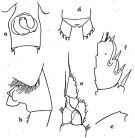 issued from : G.P. Farran in British Antarctic (\"Terra Nova\") Expedition, 1910. Natural History Reports. Zoology. Vol. VIII. Crustacea, 1929. Female: a, genital segment (ventral view); b, idem (lateral view); c, rostrum; d, anal segment and furca; e, first foot; f, third joint of exopodite of second foot.
|
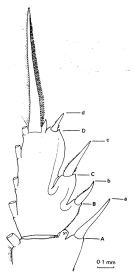 issued from : J.M. Bradford in N.Z. Jl Mar. Freshw. Res., 1981, 15 (4). [p.393, Fig.2]. Female (from McMurdo Sound): terminal part of exopod of P2 illustrating code used to describe relative lengths of outer edge spines in both sex.
|
 issued from : J.M. Bradford in N.Z. Jl Mar. Freshw. Res., 1981, 15 (4). [p.397, Fig.6]. Male (from McMurdo Sound): A, P5 (clasping a spermatophore whose neck has begun to elongate); B, terminal part of left exopod; C, serrated lamella; D, exopod of P1; E, terminal part of exopod of P2. Nota: The outer spine of the 2nd exopodal segment of P2 is shorter than the 2nd outer spine of the 3rd exopodal segment. The serrated lamella of left P5 exopodal extends beyond the hairy tubercle by about 1/4 its length and is 4/5 the length of the 3rd exopodal segment.
|
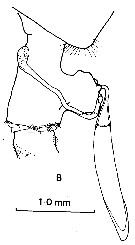 issued from : J.M. Bradford in N. Z. Jl Mar. Freshw. Res., 1981, 15. [p.392, Fig.1, B]. Female (from McMurdo Sound, Ross Sea): B, lateral view of genital segment with non-direct-placement spermatophore attached. Nota: Spermatophores of various sizes are attached to the genital segment in 2 ways; a small proportion which are short and narrow are attached directly to the genital area, but most are attached to the anterodorsal surface, usually on the right side.
|
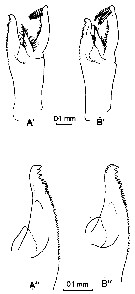 issued from : J.M. Bradford in N. Z. Jl Mar. Freshw. Res., 1981, 15. [p.395, Fig.4, A', A'', A'', B\"]. Male (from McMurdo Sound, Ross Sea): A', B', terminal part of left P5; A\"-B\", serrated lamella. Nota: The serrated lamella extends beyond the hairy tubercle for about 1/4 of the length of the lamella and is 4/5 the length of the 3rd exopodal segment.
|
 issued from : J.M. Bradford in N. Z. Jl Mar. Freshw. Res., 1981, 15. [p.401, Table 5 (part.)]. Female & Male (from Giesbrecht, 1902): Distinguishing features of species of Paraeuchaeta closely related to P. antarctica (* for code see p.393, Fig.2 above).
|
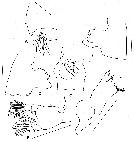 issued from M. Fontaine in Biol. Antarctic Seas XIX, Antact. Res. Ser., 1988, 47. [p.41, Fig.11]. As Euchaeta erebi. Female (from Ross Sea): A, rostrum; B-D, genital segment (left lateral, ventral, right lateral, respectively); E, Md (gnathobase); F, Md (mandibular palp). Scale bars: 0.5 mm each. Nota: Mxp with at least 1 terminal seta bearing a minute ''flagellum'' as described by Sewell (1947).
|
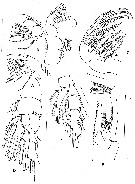 issued from M. Fontaine in Biol. Antarctic Seas XIX, Antact. Res. Ser., 1988, 47. [p.42, Fig.12]. As Euchaeta erebi. Female: A-B, Mx1; C, Mx2; D, P1; E, P2. Nota: Relative lengths of outer edge spines and setae (code see in P. antractica). Exopod of P1: Aa > AB; Bb ± 2/3 BC; Cc ± 7/5 BC. Exopod of P2: Aa ± 5/4 AB; Bb ± 2/3 BC; Cc ± 2/3 CD. In Farran's (1929) drawing both the outer edge seta on exopod 1 of P1 and the outer edge spines on P2 are somewhat shorter than in our specimens. Male: F, distal portion of left P5. Scale bars: 0.5 mm each.
|
 Paraeuchaeta erebi Female: 1 - See key to species Groups and independent species of Paraeuchaeta (p.30). 2 - An endopodal seta of Mx2 armed with long spinules in addition to dense rows of small spinules (Fig.12 C in Fontaine, 1988). 3 - Ventrally, genital field asymmetrical (Fig.11 C in Fontaine, 1988).
|
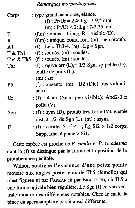 Issued from : C. Razouls in Ann. Inst. océanogr., Paris, 1994, 70 (1). [p.91]. Caractéristiques morphologiques de Paraeuchaeta erebi femelle et mâle adultes. Terminologie et abbréviations: voir à Calanus propinquus.
| | | | | Ref. compl.: | | | Razouls & al., 2000 (p.343, tab. 2, 5, Appendix); Park & Ferrari, 2009 (p.143, Table 3, 8, Appendix 1, biogeography) | | | | NZ: | 1 | | |
|
Carte de distribution de Paraeuchaeta erebi par zones géographiques
|
| | | | | | 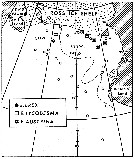 issued from M. Fontaine in Biol. Antarctic Seas XIX, Antact. Res. Ser., 1988, 47. [p.43, Fig.13]. issued from M. Fontaine in Biol. Antarctic Seas XIX, Antact. Res. Ser., 1988, 47. [p.43, Fig.13].
Occurrence of P. erebi.
Open circles show stations where no adults were found. RSSW = Ross Sea Shelf Water; CDW = Circumpolar Deep Water.
Nota: For Fontaine (1988, p.43) the occurrence of this species in the Ross Sea appears to be the first record outside of McMurdo Sound. Farran (1929) described P. erebi collected through the ice at Cape Evans. Bradford (1981) described the male, also from under the ice in McMurdo Sound, and suggests that the natural habitat for the species is under the Ross Ice Shelf and that it was carried in Ross Sea Shelf waters. |
| | | | Loc: | | | Antarct. (Ross Sea, McMurdo Sound, Cape Evans) | | | | N: | 6 | | | | Lg.: | | | (35) F: 9,5-9,2; (103) F: 9,1-8,3; M: 7,3-6,4; (397) F: 9,2-8,4; M: 7,7; 7,5; {F: 8,30-9,50; M: 6,40-7,70} | | | | Rem.: | épipélagique.
Sampling depth (Antarct.) : 0-800 m.
Voir aussi les remarques en anglais | | | Dernière mise à jour : 27/01/2017 | |
|
|
 Toute utilisation de ce site pour une publication sera mentionnée avec la référence suivante : Toute utilisation de ce site pour une publication sera mentionnée avec la référence suivante :
Razouls C., Desreumaux N., Kouwenberg J. et de Bovée F., 2005-2025. - Biodiversité des Copépodes planctoniques marins (morphologie, répartition géographique et données biologiques). Sorbonne Université, CNRS. Disponible sur http://copepodes.obs-banyuls.fr [Accédé le 21 octobre 2025] © copyright 2005-2025 Sorbonne Université, CNRS
|
|
 |
 |













